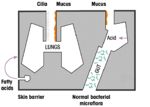Difference between revisions of "Innate Immunity Barriers"
Rjfrancisrvc (talk | contribs) |
|||
| (3 intermediate revisions by one other user not shown) | |||
| Line 11: | Line 11: | ||
'''''Mucous Membranes'''''<br /> | '''''Mucous Membranes'''''<br /> | ||
| − | Thin epithelial surfaces are necessary for the normal physiological functions of the body's mucus membranes ( | + | Thin epithelial surfaces are necessary for the normal physiological functions of the body's mucus membranes (i.e. absorption and gas exchange). They are therefore more susceptible to infection. But the body has a solution by using alternative protective mechanisms in these areas: |
| − | * The '''mucociliary escalator''' of the respiratory tract (assisted by coughing and sneezing) | + | * The [[Respiratory Epithelium - Anatomy & Physiology|'''mucociliary escalator''']] of the respiratory tract (assisted by coughing and sneezing) |
| − | * '''Peristalsis, vomiting & diarrhoea''' when necessary removes microorganisms from the | + | * '''Peristalsis, [[vomiting]] & diarrhoea''' when necessary removes microorganisms from the gastro-intestinal tract |
===Biochemical Barriers=== | ===Biochemical Barriers=== | ||
Where there are breaks in the skin that are open to the outside environment the body has an armoury of biochemical barriers that can stop infection. These are: | Where there are breaks in the skin that are open to the outside environment the body has an armoury of biochemical barriers that can stop infection. These are: | ||
* '''Lactic and fatty acids''' in sweat and sebaceous secretions are directly bacteriocidal | * '''Lactic and fatty acids''' in sweat and sebaceous secretions are directly bacteriocidal | ||
| − | * '''Enzymes''' e.g. lysozyme in saliva, sweat & tears and | + | * '''Enzymes''' e.g. lysozyme in saliva, sweat & tears and gastric acid denature microorganisms |
* Mucous itself is acidic, indigestible and traps microorganisms | * Mucous itself is acidic, indigestible and traps microorganisms | ||
==='''Commensal Organisms'''=== | ==='''Commensal Organisms'''=== | ||
| + | Commensal organisms are bacteria and yeast that live thorughout the body in a symbiotic relationship (i.e. each organism helps each other out, so not parasitic). In fact, if all the cells in the body were counted there would be a larger number of cells of bacteria than human! Their main role in immunity is to: | ||
* Out-compete pathogens at mucosal and epithelial surfaces and produce natural antibiotics | * Out-compete pathogens at mucosal and epithelial surfaces and produce natural antibiotics | ||
* When commensals are disturbed, for example with continual antibiotic use, infection with opportunistic organisms is increased | * When commensals are disturbed, for example with continual antibiotic use, infection with opportunistic organisms is increased | ||
| Line 27: | Line 28: | ||
<br><br> | <br><br> | ||
| + | {{Robert J Francis | ||
| + | |date = May 10, 2012}} | ||
| + | |||
{{Jim Bee 2007}} | {{Jim Bee 2007}} | ||
[[Category:Innate Immune System]] | [[Category:Innate Immune System]] | ||
| + | [[Category:Robert J Francis reviewed]] | ||
Latest revision as of 17:26, 18 May 2012
Physical Barriers
Skin
The simplest way to avoid infection is to prevent microorganisms gaining access to the body. The skin has an external coating of dead cells (cuticle) that, when intact, is impermeable to most infectious agents as very few pathogens are capable of penetrating the thick stratified squamous epithelium of the skin (and lower urinary tract).
- However, infection becomes a problem when there is:
- Skin loss: e.g. burns
- A break in the skin: e.g. wounds
Mucous Membranes
Thin epithelial surfaces are necessary for the normal physiological functions of the body's mucus membranes (i.e. absorption and gas exchange). They are therefore more susceptible to infection. But the body has a solution by using alternative protective mechanisms in these areas:
- The mucociliary escalator of the respiratory tract (assisted by coughing and sneezing)
- Peristalsis, vomiting & diarrhoea when necessary removes microorganisms from the gastro-intestinal tract
Biochemical Barriers
Where there are breaks in the skin that are open to the outside environment the body has an armoury of biochemical barriers that can stop infection. These are:
- Lactic and fatty acids in sweat and sebaceous secretions are directly bacteriocidal
- Enzymes e.g. lysozyme in saliva, sweat & tears and gastric acid denature microorganisms
- Mucous itself is acidic, indigestible and traps microorganisms
Commensal Organisms
Commensal organisms are bacteria and yeast that live thorughout the body in a symbiotic relationship (i.e. each organism helps each other out, so not parasitic). In fact, if all the cells in the body were counted there would be a larger number of cells of bacteria than human! Their main role in immunity is to:
- Out-compete pathogens at mucosal and epithelial surfaces and produce natural antibiotics
- When commensals are disturbed, for example with continual antibiotic use, infection with opportunistic organisms is increased
- E.g. Candida (thrush) or Clostridium difficile (infectious diarrhoea)
| This article has been expert reviewed by Dr Robert J Francis BSc(Hons) PhD Date reviewed: May 10, 2012 |
| Originally funded by the RVC Jim Bee Award 2007 |
